
Rome Campidoglio
by Philip Greenspun; created 1995
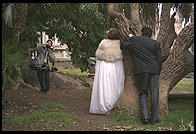
The Campidoglio ("capitol") has been the center of Rome for more than two millennia. Ancient Romans came here to make offerings at the Temple of Jupiter; modern Romans come here to make offerings to the Santo Bambino. An enormous white marble building is all that you see from Piazza Venezia. This is the Victor Emmanuel Monument, which I had always thought was erected by Mussolini but in fact was completed in 1911, some 11 years before Mussolini's rise to power. A monument to the first king of Italy, the structure today houses the tomb of the unknown soldier. My Italian friends believe that this is every American's favorite building in Rome, that it somehow uniquely appeals to our affinity for anything enormous and in bad taste. I never have the heart to tell them that the whole thing would fit nicely into the Mall of America's central courtyard.
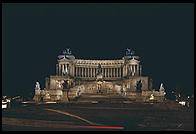
Walk around to the right of the white marble monstrosity and climb the 124 marble steps to Santa Maria in Aracoeli. The steps were a popular spot for sleeping foreigners in the 17th century, until Prince Caffarelli started rolling stone-filled barrels down the staircase. Allegedly, one can win the national lottery if one is willing to climb the steps on one's knees, but I never saw anyone do this (unlike the Scala Santa near San Giovanni, which hundreds of people climb every day on their knees).
You have to schlep all the way back down the steps and then up a staircase designed by Michelangelo to the Piazza del Capidoglio. Michelangelo was commissioned to redesign the whole piazza in 1536 by Pope Paull III Farnese. He came up with a geometric pavement design, new facades for the Senate (now the mayor's office) and the Palazzo dei Conservatori, and a third building, Palazzo Nuovo, to make the piazza a trapezoid.
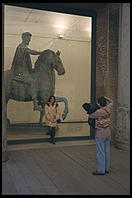 The center of the piazza used to have a gilded bronze of Marcus Aurelius on
horseback. For protection from Rome's millions of cars with no emissions controls
of any kind, the statue was moved in the 1980s inside the Palazzo Nuovo. A copy
is being finished in 1996 under the direction of
Guido
Veroi, a renowned Roman sculptor.
The center of the piazza used to have a gilded bronze of Marcus Aurelius on
horseback. For protection from Rome's millions of cars with no emissions controls
of any kind, the statue was moved in the 1980s inside the Palazzo Nuovo. A copy
is being finished in 1996 under the direction of
Guido
Veroi, a renowned Roman sculptor.
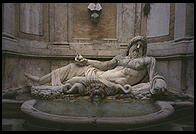 The
Palazzo Nuovo and the Palazzo dei Conservatori comprise the Capitoline Museums.
For my 10,000 lire, I prefer the Palazzo Nuovo with its many famous classical
sculptures, to its companion museum, which is yet another huge warehouse d'arte.
Make sure that you check out the hall of the philosophers on the second floor of
the Palazzo Nuovo. There are three statues of Socrates that show just how closely
he resembled a pig with his smushed in and turned up nose. Note that in the time
of Socrates being ugly was considered just as much of a sin as having bad ideas
or being stupid.
The
Palazzo Nuovo and the Palazzo dei Conservatori comprise the Capitoline Museums.
For my 10,000 lire, I prefer the Palazzo Nuovo with its many famous classical
sculptures, to its companion museum, which is yet another huge warehouse d'arte.
Make sure that you check out the hall of the philosophers on the second floor of
the Palazzo Nuovo. There are three statues of Socrates that show just how closely
he resembled a pig with his smushed in and turned up nose. Note that in the time
of Socrates being ugly was considered just as much of a sin as having bad ideas
or being stupid.
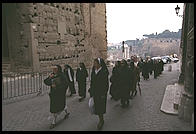 If you walk down
to the left of the old Senate you will eventually find yourself at the entrance
to the Roman Forum. You really have to use your imagination to feel the magic of
Ancient Rome because these ruins are mostly pretty well ruined. My favorite spot
is the Temple of Vesta, where six virgins kept the sacred flame alight 24
hours/day. Virgins came from noble families before they were 10 years old and
served for 30 years. Virgins who became less so were buried alive; their male
correspondents were whipped to death.
If you walk down
to the left of the old Senate you will eventually find yourself at the entrance
to the Roman Forum. You really have to use your imagination to feel the magic of
Ancient Rome because these ruins are mostly pretty well ruined. My favorite spot
is the Temple of Vesta, where six virgins kept the sacred flame alight 24
hours/day. Virgins came from noble families before they were 10 years old and
served for 30 years. Virgins who became less so were buried alive; their male
correspondents were whipped to death.
Adjacent to the temple are the ruins of the house where the Vestal Virgins lived. Their courtyard is lined with 3rd and 4th-century statues of senior Vestals. The Eyewitness guide says "On one of the pedestals the inscription has been removed because the Vestal in question suffered some disgrace. It is thought she may have been a certain Claudia, known to have betrayed the cult by converting to Christianity.
The entrance ticket to the Forum will set you back 13,000 lire and it also gets you into the Palatine Hill so you'll probably want to head up there for views out over the Forum and the Circus Maximus. This is where a lot of Ancient Rome's beautiful people lived, including most of the Emperors. A few rather sorry looking holes in the ground allegedly mark the spot of some Iron Age huts, the oldest evidence of settlement found in Rome.
You should leave by the exit near the Colosseum. This takes you right past the triumphal arch built to commemorate the destruction of Jerusalem in 70 AD. Reliefs on the inside show Roman soldiers carrying off a Sabbath menorah and other Jewish paraphernalia.
Demonstrating her reverence for her city's ancient patrimony, my friend Anna Maria said "Why would you want to see the Colosseum? It is just a bunch of holes?" Still, there is something impressive about an arena that holds 55,000 people. It was built by Vespasian starting in 72 AD using Jewish slave labor. I'd always thought that Rome got progressively more decadent until it collapsed, but gladiatorial fights were banned in 404 AD and animal fights in 523 AD. The popes used the building as a marble quarry in until the 16th century when they thought to preserve it.
From the Colosseum, you can go a few blocks south to San Giovanni in Laterano or northwest through the Circus Maximus to the Bocca della Verità ("mouth of truth"). The Bocca was allegedly a 4th-centruy BC drain cover. Now it is mounted upright and it is easy to stick your hand into the mouth. If you are lying, it will bite your hand off. The Japanese are presumably a very truthful people because I've seen numerous busloads testing each other and nobody came away maimed.
Not far from the Forum is one of the world's first multi-story shopping malls: Trajan's Markets. I've written a lot about shopping elsewhere so I think I'll confine myself to photos...